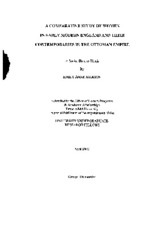| dc.description.abstract | An old Arab proverb says, "People are more akin to their contemporaries than they are to their own forefathers." Do the early modern women of England and the Ottoman Empire share more than their gender? English women of the early modern period and their Muslim contemporaries in the Ottoman Empire lived in worlds that, superficially, seem poles-apart. However, perhaps it is the emphasis on their histories that diminishes the similarities between these two groups of women. The West and the East shared at least one important characteristic -- the complicity of women in their own oppression. This paper does not attempt to answer the question that puzzles (troubles?) some modern feminists --why haven't women worked towards securing "equality" sooner. Instead, it attempts to juxtapose the lives of women in two contrasting cultures, and look at the information available from and about the period to discover what these "pre-feminist" women shared, and how they were different. During this period, English and Ottoman ambassadors, travelers and captives were experiencing their first substantial contact with the other culture. Ecclesiastical court records from early modern England give some insight as to the values which women felt they must defend. The literature from England, which gives the most thorough looks inside the early modern home, consists chiefly of domestic guides that perpetuate the patriarchal model. There are no works specifically about or by women from the 16th and 17th centuries in the Ottoman Empire; there exist only "veiled" references to women's behavior and lifestyle in works by Ottoman men. This paper attempts to look beyond cultural and gender biases within these works to discover how women behaved within their largely misogynistic environments. Are there commonalties in the ways that women celebrated everyday, and important, "female" events (from market trips to marriages), and in the ways they conducted themselves under religious, social, political and economic restrictions? The aim of this comparison is to demonstrate to the modern day reader that despite Orientalist views which still persist in the West, the histories of their Christian and Islamic foremothers are linked by more than just superficial complicity in their own subjugation. | en |


